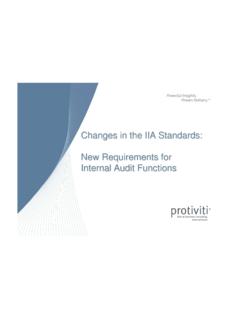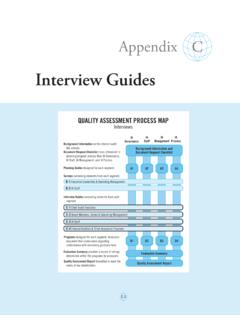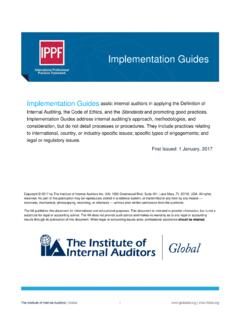Transcription of AUDITING ANTI-BRIBERY AND ANTI-CORRUPTION …
1 Practice Guide AUDITING ANTI-BRIBERY AND ANTI-CORRUPTION programs JUNE 2014 / iiiIPPF Practice Guide AUDITING ANTI-BRIBERY and ANTI-CORRUPTION ProgramsTable of ContentsExecutive Summary ..1 Introduction ..1 Global Landscape ..3 Effective ANTI-BRIBERY and ANTI-CORRUPTION programs and the Role of Internal Audit ..5 Risks, Red Flags, and Audit Activities ..11 Appendix 1: Comparison of Legislation in Select Countries ..17 Appendix 2: Internal Controls: Update Based on COSO Elements ..18 Appendix 3: Sample Audit Procedures ..18 Appendix 4: References ..20 / 1 IPPF Practice Guide AUDITING ANTI-BRIBERY and ANTI-CORRUPTION ProgramsExecutive SummaryIncreasing globalization, legal complexities, and the po-tential for serious financial and reputational harm have made the risks of bribery and corruption , and audits of ANTI-BRIBERY and ANTI-CORRUPTION programs , top corporate issues.
2 AUDITING ANTI-BRIBERY and ANTI-CORRUPTION programs requires a team of auditors with collective skills, knowl-edge, and expertise in compliance, fraud, investigations, regulatory affairs, IT, finance, culture, and ethics. On the global front, the Foreign Corrupt Practices Act (FCPA) and the bribery Act are examples of strict legal regulations, each with far-reaching interna-tional implications. And evolving ANTI-BRIBERY and ANTI-CORRUPTION legislation in China, Hong Kong, India, and other countries (see page 17) is further complicating the matter. Private and public sector organizations are in-creasing awareness of bribery and corruption exposures and fighting back through international accords, regional conventions, best practice guides, and information on per-ceptions and instances of bribery and corruption .
3 ANTI-BRIBERY and ANTI-CORRUPTION legislation has led to the development of organizational ANTI-BRIBERY and ANTI-CORRUPTION programs with well-defined components, including tone at the top/governance structure, risk as-sessment (including third-party due diligence), policies and procedures, communication and training, monitoring and AUDITING , reports and investigations, enforcement and sanctions, and reviews and updates. Internal auditors in organizations with formal ANTI-BRIBERY and ANTI-CORRUPTION programs have the opportunity to assess the effectiveness of each component and how all of the components work together to deter, curtail and detect bribery and corrup-tion.
4 Internal auditors in organizations with non-existent or in-formal ANTI-BRIBERY and ANTI-CORRUPTION programs have the opportunity to help their organizations establish a baseline by identifying and investigating red flags in high-risk areas such as third-party relationships, gifts and entertainment, political contributions, and procurement. Audit observa-tions in these and other areas can be leveraged by the or-ganization to prioritize its ANTI-BRIBERY and ANTI-CORRUPTION initiatives as input to developing and sustaining a formal ANTI-BRIBERY and ANTI-CORRUPTION ANTI-BRIBERY and ANTI-CORRUPTION programs re-quires varying levels of collaboration and information sharing with other governance functions such as regula-tory compliance, external auditors, investigators, and the governing board.
5 Before getting started, the chief audit ex-ecutive (CAE) or lead internal auditor should consult with the organization s general counsel or legal representative to gain a full understanding of potential legal implications of the audit scope, fieldwork, and findings. Introduction In 2009, The IIA released Internal AUDITING and Fraud, a practice guide designed to increase internal auditors awareness of fraud and provide guidance on how to ad-dress fraud risks on internal audit engagements. As de-scribed in the practice guide, corruption is one of several common fraud schemes and bribery is a form of corrup-tion. This practice guide complements Internal AUDITING and Fraud by providing specific guidance for assessing the effectiveness of an organization s system of internal con-trol for bribery and corruption .
6 Other related IIA guidance includes the following Practice Guides: Reliance by In-ternal Audit on Other Assurance Providers and AUDITING the Control Environment. As well, the IIA s Audit Execu-tive Center has published a Knowledge Briefing entitled Internal AUDITING and the Foreign Corrupt Practices Act (membership required). Business SignificanceOrganizations that ignore the potential impacts of bribery and corruption do so with peril. Regardless of the country, industry, or type of organization, global reach brings global 2 / Practice Guide AUDITING ANTI-BRIBERY and ANTI-CORRUPTION Programsrisk. Each region, government, and project has unique complexities, variables, and opportunities for bribery and corruption .
7 However, risks have traditionally been greater for organizations in certain geographies and industries. Related RisksBribery and corruption put businesses and governments at risk worldwide and affect organizations, private indi-viduals, and officials. bribery and corruption are found in private and public sector transactions and in dealings between the two. In fact, bribery and corruption have be-come major issues in the public sector and are especially worrisome when associated with government appoint-ments. bribery and corruption expose organizations to risks in achieving operations, reporting, and compliance objectives, and may result in: Stifled market competition.
8 The impediment of economic growth. Barriers to improved standards of living. Compromised product quality. Higher prices. Diminished trust. Discouragement of foreign direct IIA StandardsThe International Professional Practices Framework (IPPF) outlines the following International Standards for the Professional Practice of Internal AUDITING (Standards) pertaining to fraud (inclusive of bribery and corruption ). Standard 1200: Proficiency and Due Professional Internal auditors must have sufficient knowl-edge to evaluate the risk of fraud and the manner in which it is managed by the organization, but are not expected to have the expertise of a person whose primary responsibil-ity is detecting and investigating fraud.
9 Standard 1220: Due Professional Internal auditors must exercise due profes-sional care by considering the: Extent of work needed to achieve the engagement s objectives; Relative complexity, materiality, or significance of matters to which assurance procedures are applied; Adequacy and effectiveness of governance, risk management, and control processes; Probability of significant errors, fraud, or noncompli-ance; and Cost of assurance in relation to potential benefits. Standard 2060: Reporting to Senior Management and the BoardThe chief audit executive must report periodically to se-nior management and the board on the internal audit ac-tivity s purpose, authority, responsibility, and performance relative to its plan.
10 Reporting must also include significant risk exposures and control issues, including fraud risks, governance issues, and other matters needed or requested by senior management and the board. Standard 2120: Risk The internal audit activity must evaluate the potential for the occurrence of fraud and how the organi-zation manages fraud risk. Standard 2210: Engagement Internal auditors must consider the probability of significant errors, fraud, noncompliance, and other ex-posures when developing the engagement objectives. / 3 IPPF Practice Guide AUDITING ANTI-BRIBERY and ANTI-CORRUPTION ProgramsDefinitions of Key ConceptsBoard the highest level of governing body charged with the responsibility to direct and/or oversee the activities and management of the organization.









